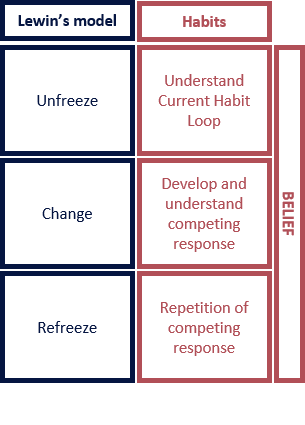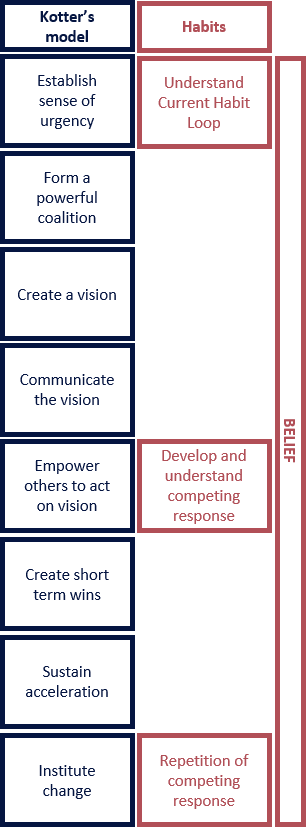Have you ever wondered why some staff struggle to adapt to organisational change?
In managing change, I have always engaged those that I identified as slow adapters from a very early stage in the change process.
I experienced that early engagement and understanding of their reason for slow acceptance of change were key in driving successful change management.
More recently I have developed an understanding of why this approach worked.
If we take a step back and look at what change is, change of any sort aims to either drive a different habit or create a new habit. Whilst communication and engagement are key drivers of effective change management, integrating an understanding of habits and how they work into your change process, can further assist in ensuring that change is not only adapted, but also maintained.
The three key areas of habits one should understand when managing change are:
- the Habit Loop;
- the Golden Rule; and
- the Importance of Belief.
Habit Loop
The habit loop is the neurological loop that controls habits consisting of cue, routine and reward.
The cue is what triggers a response, the routine is the automatic response to the cue and the reward is the result of the routine being completed.
A simple example of this is your phone makes a message sound (cue), you check and respond to your message (routine), you feel satisfied that the message has been received and responded to (reward)1.
Golden Rule
When it comes to changing a habit, the golden rule is to change the routine; not the cue or reward.
In order to do this, the person driving the change along with the impacted individual or group, first need to understand the cue. This is called awareness training.
Awareness training prompts the individual to reflect on what happens (hear, see, touch, smell, taste) or how they feel when triggered to commence the routine.
A trigger with a new routine without the reward will not give the same satisfied completion of the process and therefore will not become a habit. For effective change in habit, you must understand the reward and ensure any new routine results in the same or a similar reward.
Once the cue and reward are understood, a competing response can be designed. The competing response then needs to be practiced and repeated until the old routine decreases and the competing response becomes the new routine.
Similarly with brand new routines, you need to consider the habit loop.
In any change or new process design, consider the cue, the routine and the reward when documenting and communicating the change, making these clear.
Belief
Another key aspect of driving effective and sustainable change in habit is belief.
Belief in yourself.
Belief in the change.
Belief in the process.
Belief is the engagement piece of habit change and belief is easier when it comes as a team.
To create belief, you need to drive engagement by creating an awareness of the why.
- Why the organisation is undertaking the change; and
- Why they should be on board with the change.
The ‘why’ needs to be supported with information that enables individuals to feel confident that they are going to be able to achieve the changed state that is asked of them.
This belief and confidence in themselves can be driven by positive language, the right information at the right time, and supporting resources like training and training documentation.
Change Management
Habit change can easily be integrated into popular change management methodologies such as Lewin’s 3 step model2, ADKAR3 and Kotter’s 8 Steps to Change4 as set out below.
Getting your business from A to B
By asking ‘why’, you uncover the root cause or reason.
Through understanding the current habit loop and instilling a belief in those impacted by change, you ensure that any change becomes a new habit.
ABY Consulting gets you from A to B through understanding the ‘why’.
If you would like advice and support on change management in your organisation, please contact us now.
1 Duhigg, C 2013, ‘The Power of Habit: Why we do what we do and how to change’, Random House.
2 Lewin, K 1942, ‘Field theory and learning’.
3 Hiatt, J 2006, ‘ADKAR: a model for change in business, government, and our community’, Prosci.
4 Kotter, JP 1995, ‘Leading change: Why transformation efforts fail’.








